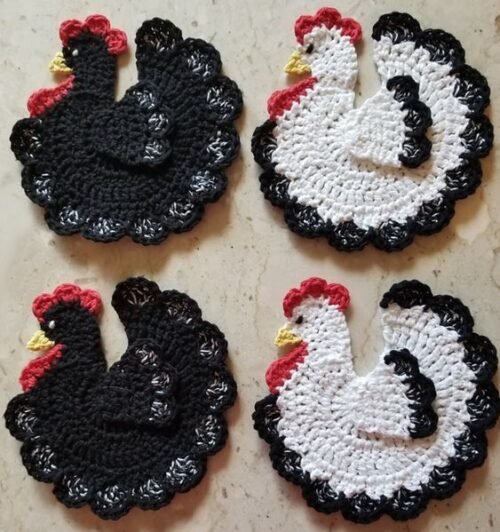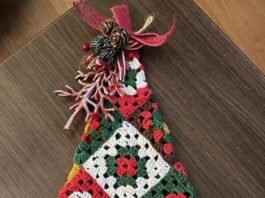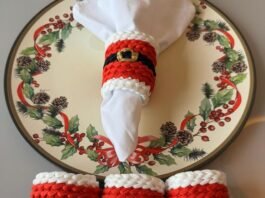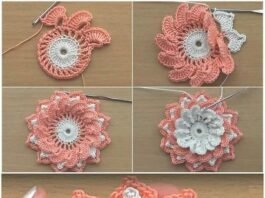Crochet chicken coasters are adorable and functional additions to any kitchen or dining table.
These whimsical coasters not only protect your surfaces from heat and moisture but also add a playful farmhouse touch to your home decor.
Perfect for springtime or as a gift for friends who love quirky, handmade items, chicken coasters are a fun, quick project for crocheters of all levels.
In this guide, you’ll find everything you need to create your own set of crochet chicken coasters, including the necessary materials, stitch techniques, and detailed step-by-step instructions. With a bit of yarn and some crochet basics, you can make these charming coasters in no time.

Materials Needed for Chicken Coasters
Gathering the right materials will help ensure your chicken coasters come out looking and functioning great. The yarn choice, hook size, and additional details make a big difference in the final look of these coasters.
- Yarn – Use cotton yarn, as it’s heat-resistant and holds up well against spills. Choose colors that resemble a chicken’s natural coloring, like white, cream, or brown for the body, and red, yellow, or orange for the beak and comb.
- Crochet Hook – For medium-weight cotton yarn, a 4mm crochet hook is ideal. If you’re using thinner or thicker yarn, adjust the hook size accordingly to maintain a firm structure in your coaster.
- Additional Supplies – You’ll also need scissors, a tapestry needle for weaving in ends, and a stitch marker, which can help you track your progress if you’re new to crocheting in the round.
Step 1: Creating the Chicken’s Body
The body of the chicken coaster starts with a simple circle that forms the main base. This circular base will be the central part of the coaster, providing stability and shape.
- Form a Magic Ring – Begin with a magic ring, which is a great way to start circular crochet projects. Insert your hook into the ring and pull up a loop to create the first stitch. This loop will be tightened at the end to close up the center of your circle.
- First Round of Double Crochets (DC) – Chain 2 (which counts as the first DC), then crochet 11 more DCs into the magic ring for a total of 12 stitches. Pull the tail to close the ring, and slip stitch into the top of the chain-2 to complete the first round.
- Building the Circle with Increases – In the following rounds, increase evenly by adding two DCs in each stitch of the previous round until you reach the desired coaster size. Aim for about 3 to 4 rounds of increases to get a coaster-sized circle.
Step 2: Shaping the Chicken’s Head
The next step is to add a small circular head shape to one side of the main body. This head piece will be a smaller circle attached directly to the body.
- Attaching Yarn for the Head – Join a new piece of yarn in a contrasting color where you’d like the head to be placed, ideally near the edge of the main body circle. Chain 2 as the starting DC for the head.
- Crocheting the Head Circle – Work 6 DCs into the same stitch to form a small circle. This creates a compact shape that represents the chicken’s head. Slip stitch into the first DC to close the round.
- Adjusting Size if Necessary – If you’d like the head to appear larger, add a second round of increases by crocheting 2 DCs in each stitch from the previous round. Otherwise, you can leave it as a smaller, rounded shape.
Step 3: Adding the Chicken’s Beak and Comb
No chicken coaster would be complete without a cute beak and comb! Adding these small details brings personality and charm to the design.
- Creating the Beak – Attach yellow or orange yarn near the center of the chicken’s head. Chain 3, then slip stitch back into the starting stitch to create a small triangular beak. Cut and weave in the yarn ends to secure it.
- Making the Comb – For the comb, join red yarn at the top of the chicken’s head. Chain 2, then work three single crochets (SC) in the same stitch. Slip stitch into the next stitch to create a slight “wave” for the comb. This gives the chicken its characteristic crown.
- Finishing Details – Weave in all loose ends to secure each feature. Take a moment to adjust the beak and comb if necessary, ensuring they are centered and securely fastened to the head.
Step 4: Adding the Tail Feathers
For an extra decorative touch, add a few tail feathers at the opposite end of the chicken’s body. This is an optional step but adds a cute flair to your chicken coaster.
- Attaching Yarn for the Tail – Join a contrasting yarn color at the bottom of the coaster. Chain 4, then slip stitch back into the same stitch to form the first tail feather.
- Creating Additional Feathers – Chain 4 again, slip stitch in the next stitch, and repeat as desired. Typically, two or three tail feathers give a full look without overcrowding the design.
- Securing the Tail – After adding the feathers, weave in the yarn ends and secure them firmly to the coaster. This ensures that the feathers won’t come loose over time and that the coaster remains durable with repeated use.
Step 5: Adding Finishing Touches and Assembling a Set
With your first chicken coaster complete, consider creating a set. Making a few additional coasters lets you experiment with different colors or details, adding variety to your collection.
- Creating Multiple Coasters – Make several chicken coasters in different colors for a cohesive yet diverse set. Try changing the body, beak, or comb colors for fun variations that stand out as a unique collection.
- Adding Eyes – For an extra touch of personality, embroider small black eyes near the beak using black yarn or embroidery floss. A small stitch is enough to add character without overwhelming the design.
- Blocking the Coasters – After weaving in all ends, consider blocking your coasters to ensure they lie flat. Blocking involves gently wetting and reshaping your coasters on a flat surface to set the stitches. Let them dry completely before use.
Project Ideas and Uses for Chicken Coasters
Chicken coasters make wonderful additions to any home and are especially fun for gifting. Their playful design suits many occasions, and they’re versatile enough to use in different ways.
- Great for Gifting – Handmade chicken coasters make delightful gifts for farmhouse-style lovers or anyone with a rustic kitchen decor. Consider packaging them in sets of four or six, tied with a bit of ribbon or twine for an extra special presentation.
- Multipurpose Use – Besides using them as coasters, these chicken designs can serve as decorative accents in the kitchen. Use them as small trivets, pot holders, or even attach them to bags or aprons as cute embellishments.
- Personalizing Your Coasters – Add a unique touch by using different yarn textures, such as variegated or speckled yarns, to create “feathery” effects. Experimenting with yarn colors and stitch styles will help you create one-of-a-kind coasters that stand out.
Crocheting chicken coasters is a creative and enjoyable project that brings both function and fun to any home. Whether you’re a beginner looking for a simple project or an experienced crocheter wanting to add some charm to your kitchen, these chicken coasters are a delightful addition to your crochet repertoire.
With their playful design and easy-to-follow pattern, these coasters can quickly become a favorite go-to project. So grab your yarn and hook, and start crafting your own flock of adorable chicken coasters today!



